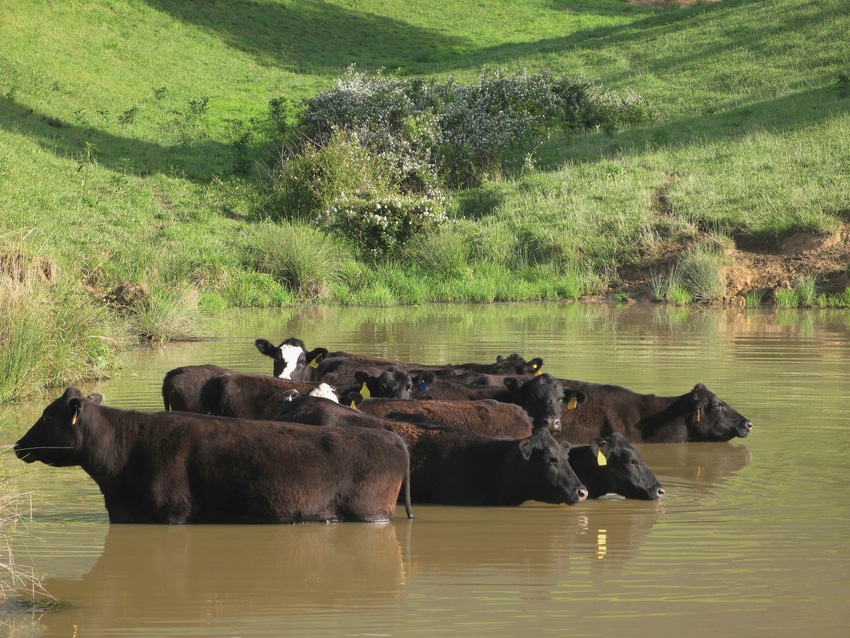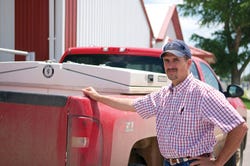Three veterinarians and a nutritionist explain how nutrition consulting can enhance client relationships and improve herd health.
August 27, 2014

Fresh out of veterinary school, Gregg Hanzlicek, DVM, Ph.D., began working at a dairy-focused veterinary practice in Wisconsin. There, veterinarians were often a major resource for nutritional consulting as well as animal health. The interplay between the two allowed practitioners to help holistically address challenges.
When Dr. Hanzlicek started his own practice, Bovine Production Services in Amelia, NE, his cow-calf clients weren’t expecting their new veterinarian to talk about nutrition, but consulting was something he felt strongly about including.
“On the dairy side, most people understand that nutrition is the foundation for everything,” Dr. Hanzlicek says. “Having that dairy background did help me start ranchers with the idea that nutrition is important. It’s a huge economic part of the cow-calf operation. At least 50 percent of expenses have to do with feed.”
Starting small, he first offered to simply test forages and help balance rations. Dr. Hanzlicek later included body scoring the herd, ration formulation and building a custom mineral program for clients based on specific deficiencies in their pasture. Recommendations were backed up with estimates for savings in feed costs and improvements in animal health.
Paying for nutritional services was a change for most of his customers, but he emphasized the direct connection with improved production. Body condition and nutrition at calving is a key to calving success—resulting in less dystocia, improved neonatal calf health, a reduction in scours and fewer incidences of preweaning pneumonia, Dr. Hanzlicek notes.

Dr. Greg Hanzlicek
“None of them are going to switch without having something on paper to show an economic benefit,” he says. “I could talk about interaction between nutrition and production. That connection made people start thinking maybe a veterinarian is the correct person to be providing these services.”
Nutrition consulting also made a difference in his practice by adding services in the summer months. In addition, it helped him develop a stronger relationship with his clients and put him on their operation more times a year. Typically, Dr. Hanzlicek visited four times a year just for nutritional consulting in addition to traditional pregnancy checking and breeding soundness examinations.
“We were on the facility at least six times a year,” he says. “Being there more often gave us fresh eyes on the cows and built stronger relationships with clients, not to mention a steady income.”
Not all veterinarians have tools to immediately add nutritional consulting to their practice. Dr. Hanzlicek invested in additional education while he was in practice and continued that philosophy all the way to earn a doctorate in veterinary epidemiology. Now, he serves as the director of Production Animal Field Investigations at the Kansas State Veterinary Diagnostic Laboratory. However, his clients still rely on him to travel back to Nebraska several times a year to continue consulting.
“I never had a cow-calf operator that started the service quit,” he says. “I was providing a service not offered in that part of the country before.”
Adding to a New Practice
Terry and Sarah Foust, DVMs, are slowly starting to add nutritional consulting to their new practice, River View Veterinary Service LLC, in Port Byron, IL. The husband-and-wife veterinary team started the mixed animal practice about one year ago.
In their previous practices, nutritional consulting wasn’t a priority even though large animal clients regularly asked questions about nutrition programs. As their new business got off the ground, the veterinarians began to evaluate the nutritional consulting needs of cow-calf operators in the area, develop their skills and determine an offering.
“Most of the clients are just looking to see if their existing ration looks good, check their supplements and make sure their cattle are all in good shape,” Dr. Sarah Foust says. “We do have a few clients that send us their feed samples. Then, we provide an analysis, make a good ration and balance it every two or three months. It’s nice to see the results and exciting to see how the ration is working.”
As veterinarians, Dr. Sarah Foust says they are in the position to see the evidence of nutritional changes firsthand in improved conception rates and calf health.
In fact, their growing business has already had several successful cases. Dr. Terry Foust notes that one cow-calf producer with a year-long calving interval was seeing increased incidence of retained placenta. After evaluating body condition of the herd, the veterinarians found the clients cattle were too thin and adjusted the ration. In addition, the veterinarians worked with the producer to change other management practices that decreased the calving interval timeframe and helped improve the retained placenta problem. As a result, the last calving season was completed in a tighter timeframe—within 60 to 90 days—and had only one retained placenta.
“The overall health of the herd was improved,” Dr. Terry Foust says. “Pregnancy rates were just as good as they were before, but the producer was happier and more efficient.”
The animal health effects from nutrition were known from their basic veterinary education, but learning how to test and manage clients’ nutritional programs was a skill both veterinarians added through additional training. They attended a seminar taught by Mark Hilton, DVM, clinical professor at the Purdue University College of Veterinary Medicine. After training, they introduced nutritional consulting to their new practice gradually.
“We picked one of our really good producers and said ‘Here’s what we’d like to do. We won’t charge you for the first year until we get this worked out,’” Dr. Sarah Foust says. “It really took off, and he’s been a believer ever since. That’s how we got our foot in the door, just asking how our clients are doing with their ration.”
The veterinarians currently focus on ration balancing and leave supplementation decisions up to the producers in cooperation with their supplier.
“For us, it’s more about relationships than the bottom line,” Dr. Terry Foust says. “People know it’s more profitable for us, and it helps our bottom line when we can show value to the producers and form long lasting bonds with these people.”
Know When to Call an Expert
When Randall Spare, DVM, president of the Ashland Veterinary Center in Ashland, KS, graduated from veterinary school, he immediately noticed the connection between nutrition and herd health problems. He sought additional information from conferences and publications to help supplement his expertise for the benefit of his cow-calf clients.
As a result, every herd visit incorporates both traditional animal health and nutritional consulting. The services aren’t billed separately. Rather, Dr. Spare sees both as the same side of one service: helping the client succeed.
“We don’t bill it separately,” Dr. Spare says. “Our goal is to help our producers stay in business. Many times we’re doing that while we’re preg checking or fertility testing bulls. We’re always assessing the body condition of this cow or this bull.”
Dr. Spare focuses on testing forages and developing rations. Many producers have incorporated ethanol by-products or alternate forages, which has given the clinic an opportunity to help clients find a lower-cost substitute in harder times.
“I’m a veterinarian, and I’m not a nutritionist,” he says. “We can develop the very best vaccination program for a producer and he can have the very best genetics, but if he doesn’t have an adequate nutritional program, the genetic potential won’t be realized. I soon realized many producers aren’t going to hire nutritionists so we need to be more knowledgeable.”

Dr. Randall Spare, Ashland Veterinary Center in Ashland, KS
Even with additional education and years of experience, Dr. Spare says he knows when to call a nutritionist in to help address more complex nutritional challenges.
“It’s just knowing your limitations,” he says. “You always want to give people other options. When we as veterinarians say ‘can you help us in this area?’ we’re creating teamwork. And we show our clients that we want the best for them when we say ‘let’s get these other people involved, and find resources that are more capable.’”
A collaborative effort is key to maximizing producer profitability and managing animal health, notes Jeff Hill, Ph.D., nutritionist and beef business manager with ADM Alliance Nutrition.
“Every professional working for the benefit of the producer and his herd should look for a proactive approach to problem solving and defer to the more knowledgeable source,” Hill says. “Whether it’s a poor condition score or performance problems without obvious health issues, there can be a gray area where a good team approach would work best.”
Especially in the cow-calf sectors, veterinarians can help head off animal health issues with sound nutrition recommendations. The three components to a healthy herd include good animal husbandry, good pasture management, and good nutrition which enable cattle to utilize forage efficiently and minimize waste, he notes.
“Good nutrition in a cow-calf herd may help resolve rebreeding problems, address digestive tract upset and even help cattle’s immune system respond to vaccines,” Hill says. “If you have to play catch up with keeping an animal in condition and managing grass, you’ll end up spending more money to make up for something you could have prevented.”
For cow-calf operators, the connection between nutrition and resulting health challenges is clear. However, he notes that more mature animals in the stocker and feedlot sector require specialized nutrition to maximize growth, but their health challenges are less often a direct result of nutritional deficiencies.
For all sectors, veterinarians, nutritionists and feed companies will have to work more closely together than ever before as veterinary feed directives (VFDs) become more commonplace.
“Grazing operations present a unique situation where VFDs and a good veterinaria-client relationship is imperative along with purchase of feed products from a company that has experience handling VFDs,” Hill says. “Feed products offer a significant delivery mechanism for medications in grazing scenarios, especially those where control and prevention of anaplasmosis is critical.”
Other trending headlines:
Take A Tour Of The 2014 Yamaha Viking SxS
Ranching Is A Family Affair: Meet The Generations On The Ranch
Beef Demand Roars, Record Cattle Prices Projected Into 2015
Enjoy This --> Picture Perfect Summer Grazing Scenes From Readers
Grass-Fed Vs Grain-Fed Ground Beef | Are There Any Difference In Healthfulness?
How To Prevent & Treat Pinkeye In Cattle
100+ Photos Of Our Favorite Ranch Dogs
How Drones May Change Food Production From Pasture To Plate
Why Is Death Loss Increasing In Heavier Beef Cattle?
You May Also Like



